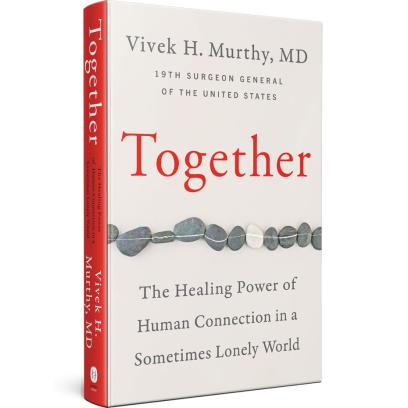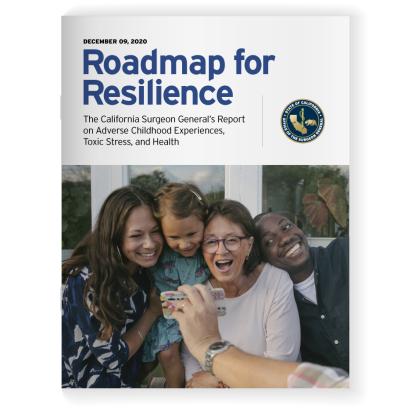The Value of Social Connection
In Together: The Healing Power of Human Connection in a Sometimes Lonely World (Harper Wave, 2020), US Surgeon General Vivek Murthy takes on a topic with increasing relevance in the COVID-19 world—loneliness and the challenges of social connection—from a health perspective. From birth, we have a biological need for meaningful connection with others in the same way we need food and water; and like hunger or thirst, Murthy says, the feeling of loneliness is the body’s way of telling us we need human connection. If we don’t or can’t address that need when it arises, the sympathetic nervous system can go into overdrive, leading to cardiovascular stress and increased inflammation over time. People with weak social relationships have a greater risk of heart disease, hypertension, stroke, dementia, depression, and anxiety and are as likely to die prematurely as those who smoke 15 cigarettes a day. But with strong social relationships, people sleep better, have stronger immune systems, and live longer.
According to Murthy, one of the biggest challenges in addressing loneliness is that people often feel shame about admitting it, especially men, teenagers, and elderly people. Living in a competitive, individual-oriented, and politically divided society like the United States contributes to the problem. Social media can be a double-edged sword, too: it allows us to connect with others and can provide valuable community for people who may be marginalized in other social environments (such as LGBTQ youth), but it can also contribute to social isolation by encouraging harmful comparisons and substituting transactional, surface-level interactions for more meaningful ones.
As Murthy points out, loneliness is a signal, not an accusation of unworthiness. Recognizing the problems it creates offers us an opportunity to begin building a culture of connection based on meaningful intimate and social relationships and on shared purpose in our communities.
We show our innate desire for connections and relationships in the way we rally around friends, family, neighbors, and communities in crisis, even when they’re on the other side of the world. We deliver home-cooked food, send money, publicly express support, and march in solidarity. So how do we bring that atmosphere of mutual concern and service with us into the rest of our lives? According to Murthy, it has to start on an individual level because that’s where loneliness begins.
It’s important to spend time in reflection, so we can gain self-knowledge and work toward self-acceptance, and to engage with others in mutually caring relationships that can reinforce our growing self-compassion. We have a responsibility in our communities, too, to treat those we encounter as complex, multifaceted people deserving of consideration and kindness. Employers can counter loneliness by working to create a culture in which each employee feels known, respected, and cared for, modeled by the leadership and encouraged through the thoughtful development of inclusive policies and practices. And for local, state, and federal governments, it’s essential to understand how policies—such as limited access to parks and libraries or immigration laws that make it difficult for families to be together—can increase loneliness and to take action to increase human connection.
Preventing ACEs and Toxic Stress to Advance Equity
The prevalence of adverse childhood experiences (ACEs) is a public health crisis that has only grown with the additional stressors of the COVID-19 pandemic. Without the buffering effects of responsive and loving adult care and community support, a child exposed to repeated or sustained adversity—abuse, neglect, or other challenges such as divorce or a family member’s substance misuse or mental illness—may experience toxic stress. Unlike lower levels of stress that are healthy or tolerable, toxic stress can affect neurological, endocrine, immune, and metabolic development. In addition to increasing the likelihood of a toxic stress response, acute stressors like the pandemic can reduce access to valuable sources of support, like schools, health providers, and community organizations, and increase occurrences of household violence, among other effects. Because of COVID-19, many children have been largely isolated from their peers and their community support systems for more than a year; lost jobs, food insecurity, and the illness or death of loved ones may also have caused household upheaval. All of these factors increase the risk of toxic stress.
ACEs and toxic stress are present in every demographic group but are disproportionately high for members of already vulnerable populations, including racially marginalized people; people who are unemployed, unable to work, or have low incomes; people without adequate health insurance; and LGBTQ people. The health effects can ripple down through generations, and so can the social and economic ones. ACEs are associated with 9 of the 10 leading causes of death for adults in the United States; they’re also connected to increased likelihood of unemployment, poverty, homelessness, incarceration, and more—and they cost the United States hundreds of billions of dollars per year in healthcare, education, social services, and lost productivity. If we want to build a more equitable world, we have to work to prevent ACEs and toxic stress.
All of these challenges, and a path forward, are laid out in Roadmap for Resilience: The California Surgeon General’s Report on Adverse Childhood Experiences, Toxic Stress, and Health, which explains the science of ACEs and California’s plan to reduce them by half in one generation. It’s an ambitious plan, but research shows that even simple interventions can make significant differences. At 400-plus pages, plus supplementary materials, the report offers health professionals, policymakers, public employees, and advocates an invaluable set of resources to understand, recognize, and work to prevent ACEs, and to provide compassionate care and much-needed relief to children and adults.
California’s roadmap stresses the importance of primary, secondary, and tertiary prevention, which build on each other and are all essential to reducing ACEs. Primary prevention focuses on proactive investment in nurturing relationships and strong, healthy communities at individual, family, local, state, and federal levels. Key strategies are to
- raise awareness about the effects of ACEs and how to help children develop healthy stress responses;
- support positive adult-child relationships;
- build individual, family, and community resilience; and
- address social determinants of health like increasing access to early childcare and education, cleaning up environmental contamination, and reducing structural racism in healthcare, education, and justice systems.
The most critical element is coordinated, cross-sector training in and implementation of ACEs-aware and trauma-informed practices involving first responders, health professionals, social workers, educators, public safety workers, and more.
This training facilitates secondary prevention efforts, which focus on early detection and evidence-based interventions for children experiencing adversity. The goal is to prevent the development of toxic stress physiology and resulting health issues through
- early screening for ACEs, ACEs-associated health conditions, and protective factors;
- education about toxic stress and strategies to regulate stress responses; and
- team-based care that includes health professionals, social workers, educators, and local agencies as needed.
For children and adults who already exhibit evidence of a toxic stress response, tertiary prevention aims to improve outcomes (in turn acting as primary prevention for the next generation). Tertiary prevention methods can decrease the likelihood or lessen the severity of ACEs-associated health conditions by helping people
- build healthy, supportive relationships;
- sleep well, eat nutritious foods, engage in regular exercise, and practice mindfulness; and
- access culturally competent mental and behavioral healthcare as needed.
For these tertiary strategies to be effective, it’s essential that healthcare, public health, social services, education, justice, and other sectors work to prevent further harm. This effort has to occur at the individual level—for example, by making sure a child with asthma and the child’s caregivers understand the condition and have access to medication, regular checkups (with compassionate, trauma-informed providers), and transportation so they don’t miss appointments. But it’s just as important to prevent harm at the structural level through legislation and policy changes, such as efforts to decriminalize homelessness and mental illness so that people who are housing insecure or have mental illness can receive care and support rather than punishment.
Roadmap for Resilience emphasizes that reducing ACEs is possible with concerted efforts both within and across multiple sectors, as well as in partnership with families and children. After summarizing the research base, the first half of the report offers detailed recommendations for each sector and at each level of prevention, including case studies and special sections on the compounding role of COVID-19; the second half outlines California’s specific strategies and the statutory framework, including the ACEs Aware Initiative, as a model other states can learn from. Download the full report and sector-specific briefs, and watch an introductory webinar, here. To take your learning further, join regular, free webinars hosted by the ACEs Aware Initiative (some qualify for continuing education credits) here.


